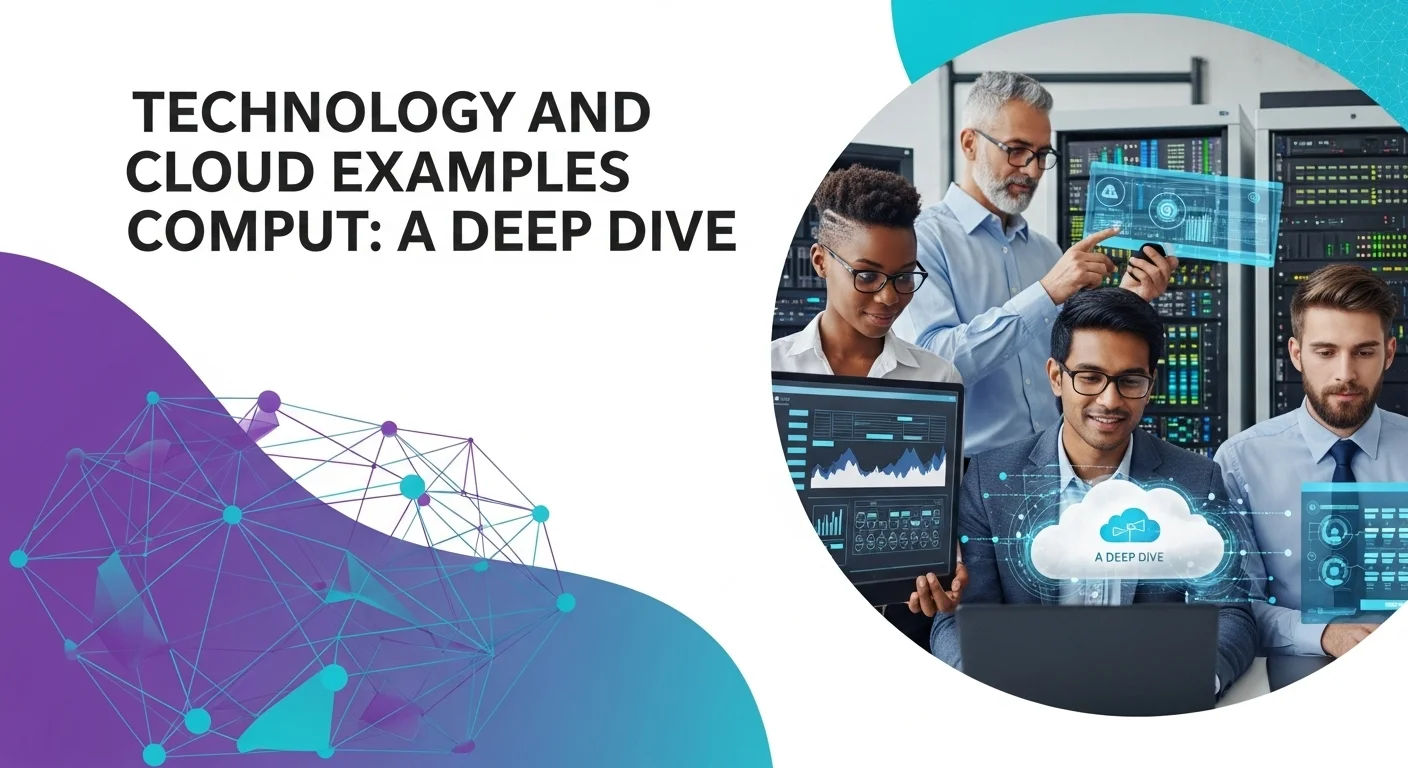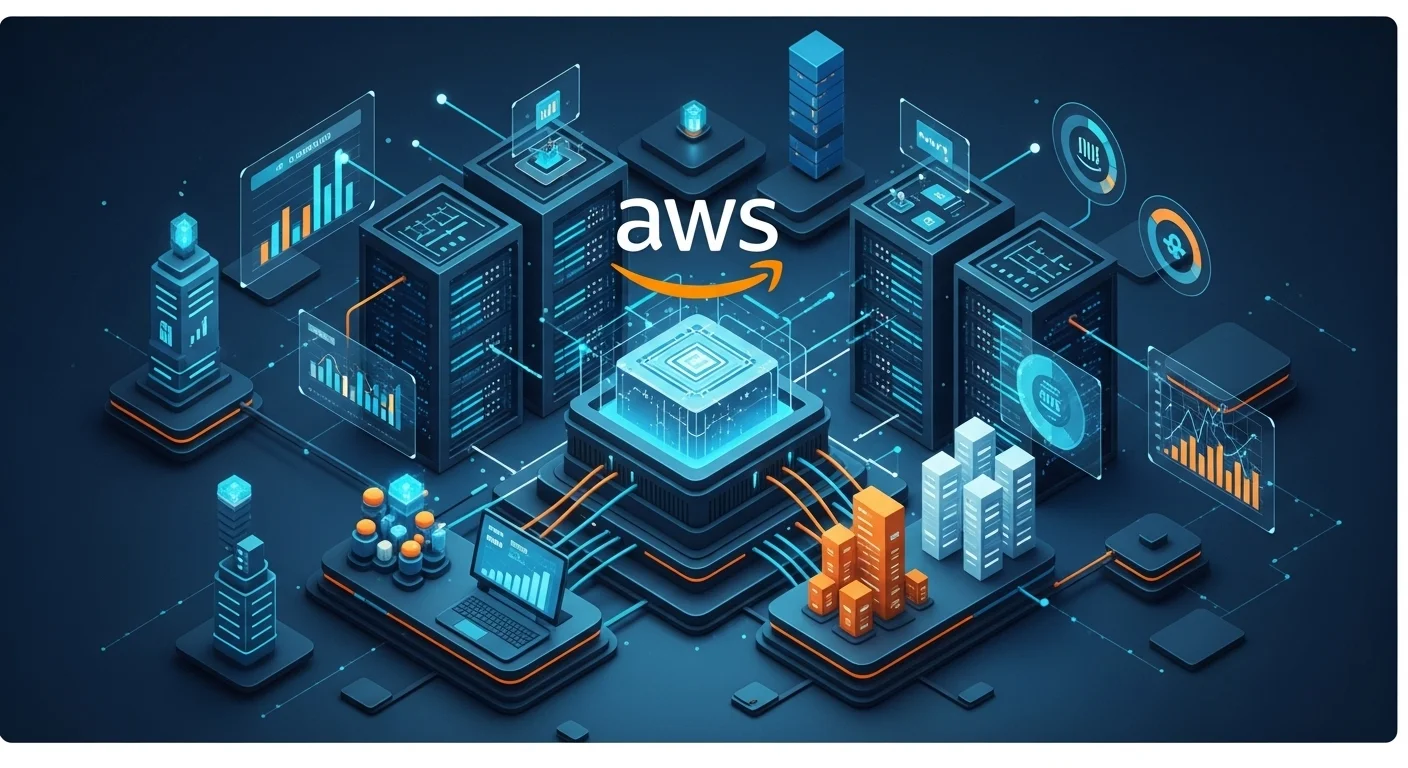Cloud Computing in Action: A Practical Guide to Real-World Examples

Executive Summary
For over a decade, I've been in the trenches, helping businesses move to and thrive in the cloud. I've seen firsthand that understanding cloud computing isn't about memorizing acronyms; it's about seeing how it works in the real world. This guide is my attempt to share that practical knowledge. We'll skip the dry theory and jump right into tangible examples of how services like AWS, Azure, and Google Cloud are powering the websites and apps you use every day. We'll cover everything from the basic building blocks (IaaS) to ready-to-use software (SaaS), showing you how these technologies drive real business growth and efficiency.
Table of Contents
Table of Contents
- What is Cloud Computing and Why Does It Matter?
- The Core Service Models: IaaS, PaaS, and SaaS
- A Closer Look at IaaS in Action
- Why the Cloud is a Game-Changer for Modern Business
- Deep Dive into IaaS Providers: AWS vs. Azure vs. GCP
- Cloud Adoption Strategies: The 6 R's of Migration
- Case Study: How Netflix Mastered the Cloud
- Pro Tips for Cloud Cost Management (FinOps)
- Essential Tips for Boosting Your Cloud Security
- Using Advanced Cloud Tech for Innovation
What is Cloud Computing and Why Does It Matter?
In my line of work, I see people get bogged down by tech jargon all the time. So let's simplify things. When we talk about understanding cloud computing through practical examples, we're really just asking, "How does this stuff actually work in the real world?" At its heart, cloud computing is about renting, not buying. Instead of owning and maintaining your own expensive servers and data centers, you access computing power, storage, and databases over the internet from a provider like Amazon Web Services (AWS), Microsoft Azure, or Google Cloud. You pay for what you use, just like your electricity bill. The beauty of studying real-world cloud examples is that it demystifies this powerful technology, making it clear and actionable for everyone, from business owners to developers.
The importance of this is massive because the cloud has completely reshaped how businesses operate. I've worked with tiny startups and huge global companies, and they all use the cloud to innovate faster, scale their operations, and work more efficiently. Think about the services you use daily, like streaming a movie on Netflix or collaborating on a file in Google Docs. These are perfect examples of cloud-powered applications. They rely on a vast, hidden infrastructure managed by cloud providers to deliver a seamless experience to you. You don't have to worry about the complex hardware and software running in the background; it just works. By looking at how these websites and services are built, we can truly appreciate the architecture that makes our modern digital lives possible.
The Core Service Models: IaaS, PaaS, and SaaS
To really get a handle on cloud computing, you need to know the three main service models. I like to think of it like ordering a pizza. Each model offers a different level of control and convenience.
- Software as a Service (SaaS): This is like having a pizza delivered to your door, ready to eat. It's the most common model where you use a complete software application over the internet, usually through a subscription. The provider handles everything—the infrastructure, the platform, the software itself. You just log in and use it. Think of Salesforce for managing customer relationships, Microsoft 365 for your documents and email, or Dropbox for storing files. These solutions give businesses powerful tools without the headache of managing the underlying tech.
- Platform as a Service (PaaS): This is like buying a take-and-bake pizza. You get the dough, sauce, and cheese, but you get to add your own toppings and bake it in your own oven. PaaS provides developers with a platform—including servers, storage, and development tools—to build and run their applications without worrying about the low-level infrastructure. Services like Heroku or Google App Engine are great examples. They let development teams focus purely on writing great code and launching new features quickly.
- Infrastructure as a Service (IaaS): This is like buying the flour, yeast, tomatoes, and cheese to make a pizza from scratch. IaaS gives you the fundamental building blocks of computing: virtual servers, storage, and networking. It offers the most flexibility and control. This is where you find the core services from giants like AWS, Azure, and Google Cloud. For instance, Amazon's EC2 gives you virtual servers, and their S3 service provides storage. Companies like Netflix use these building blocks to construct their entire global platform. Understanding these IaaS examples is key to seeing how the biggest services on the internet are built.
A Closer Look at IaaS in Action
Infrastructure as a Service (IaaS) is the foundation of the cloud world, offering incredible power and scale. When I explain IaaS to clients, I point to the core components they can rent. The top players here are, without a doubt, Amazon Web Services (AWS), Microsoft Azure, and Google Cloud Platform (GCP).
The most classic IaaS example is the virtual machine (VM). AWS calls them EC2 instances, Azure calls them Virtual Machines, and GCP calls them Compute Engine instances. Think of them as computers you can rent in the cloud and spin up in minutes. I've seen startups launch their entire business on just a few VMs, hosting their website and backend application. They only pay for the exact resources they consume. Then, as their user base grows, they can instantly add more VMs or use more powerful ones. Trying to do that with physical hardware would be incredibly slow and expensive. This flexibility is the magic of IaaS.
Storage is another pillar of IaaS. Services like AWS S3, Azure Blob Storage, and Google Cloud Storage offer incredibly reliable and scalable storage for almost any kind of data. Many of the websites and apps you use every day rely on these services to store everything from your profile picture to huge datasets for analysis. A social media app, for example, uses this type of storage to hold the billions of photos its users upload. The pay-as-you-go pricing is perfect here because costs grow in lockstep with the amount of data stored.
Finally, networking services within IaaS, like Virtual Private Clouds (VPCs), let companies carve out their own private, isolated corner of the cloud. This gives them the same security and control they would have in a traditional data center, allowing them to define their own network layout and ensure their resources can communicate securely and efficiently.
Why the Cloud is a Game-Changer for Modern Business
I can't overstate how crucial understanding these cloud examples is for business today. The cloud isn't just a piece of tech; it's a strategic tool that fuels growth and agility. The benefits I see companies realize time and time again are huge:
- Serious Cost Savings: The cloud turns a massive upfront capital expense (buying servers, building data centers) into a manageable operational expense. There's no need to pay for server racks, massive electricity bills, or a large team of IT experts just to keep the lights on. The pay-as-you-go model gives you fine-grained control over your spending.
- Unmatched Scalability and Flexibility: The cloud lets you scale your resources up or down at a moment's notice. I've helped retail clients handle the massive traffic spike of Black Friday without a hitch, something that would be a nightmare with fixed, on-premise hardware.
- Collaboration from Anywhere: Cloud-based tools have made remote and hybrid work not just possible, but productive. Teams can access, edit, and share information in real-time, no matter where they are in the world.
- Rock-Solid Disaster Recovery: Cloud providers offer backup and disaster recovery solutions that are simpler and more affordable than traditional methods. By easily replicating data and infrastructure across different regions, businesses can stay online and recover quickly from any outage.
- Access to Cutting-Edge Tech: This is one of my favorite parts. The big cloud providers are constantly innovating. By using their platform, any business can tap into powerful technologies like artificial intelligence (AI), machine learning (ML), and the Internet of Things (IoT) without having to build it all from scratch. This levels the playing field and allows companies to build smarter, more innovative products.
To wrap up this section, really digging into real-world cloud applications is the best way to grasp one of the most important tech shifts of our era. By analyzing how everything from basic IaaS building blocks to polished SaaS applications work, you can truly appreciate the power of the cloud. For anyone in tech or business leadership today, understanding these examples isn't just nice to have—it's essential for survival and success in our digital world.

A Complete Guide to Cloud Technologies and Business Solutions
To truly master how cloud computing works in practice, you have to go deeper than just the definitions. It's about understanding the specific tools, the business playbooks, and how the major players stack up against each other. In this part of the guide, I want to give you a detailed look at how to apply cloud technologies, offering the kind of insights I share with technology leaders and business strategists. By dissecting real IaaS examples, different cloud solutions, and the architecture of popular websites, we can build a solid framework for making smart cloud decisions.
An In-Depth Analysis of IaaS Providers: AWS vs. Azure vs. GCP
Infrastructure as a Service (IaaS) is the engine room of the cloud, and the market is largely run by three giants: Amazon Web Services (AWS), Microsoft Azure, and Google Cloud Platform (GCP). In my experience, choosing the right one depends heavily on your specific situation. Let's break them down.
Amazon Web Services (AWS)
As the first major player on the scene, launching way back in 2006, AWS has the most mature platform and the widest array of services. It's often the default choice for a reason.
- Compute: Their flagship is Amazon EC2, offering a mind-boggling variety of virtual servers for any workload you can imagine. This is the quintessential IaaS example. For a more modern approach, AWS Lambda lets you run code without even thinking about servers (known as serverless).
- Storage: Amazon S3 is the undisputed king of object storage. It’s incredibly durable and used for everything from hosting website images to storing massive data lakes. For servers, Amazon EBS provides the persistent disk storage they need.
- Networking: Amazon VPC lets you create your own private, isolated network in the cloud, giving you complete control over your virtual networking environment.
- Databases: They make running traditional databases easy with Amazon RDS, and for massive scale, their NoSQL database, DynamoDB, is a powerhouse.
Microsoft Azure
Azure is a formidable competitor, especially in the corporate world. I find that companies already heavily invested in Microsoft products (like Office 365 or Windows Server) often gravitate toward Azure because of the seamless integration.
- Compute: Azure Virtual Machines are their core compute offering, with great support for both Linux and Windows. Azure Functions is their answer to AWS Lambda for serverless code execution.
- Storage: Azure Blob Storage is their solution for massive unstructured data, while Azure Disk Storage provides high-performance storage for their VMs.
- Networking: Azure Virtual Network (VNet) is very similar to AWS VPC, allowing for secure and private cloud networks.
- Databases: Azure SQL Database is a top-tier managed service for relational databases, and Azure Cosmos DB is a fascinating, globally distributed NoSQL database that can handle almost any data model.
Google Cloud Platform (GCP)
GCP's strengths lie in the areas where Google itself is a world leader: big data, machine learning, and networking. I often recommend GCP to clients whose business revolves around data analytics.
- Compute: Google Compute Engine provides powerful and scalable VMs. They also have Google Cloud Functions for serverless applications.
- Storage: Google Cloud Storage offers a unified object storage solution, and Persistent Disk provides block storage for their VMs.
- Networking: This is a key differentiator for GCP. Their global VPC allows VMs in different parts of the world to communicate over Google's private network, which is incredibly fast and secure.
- Databases and Analytics: This is where GCP truly shines. Services like BigQuery, a serverless data warehouse, and Cloud Spanner, a globally-distributed relational database, are game-changers for data-heavy companies.
Business Techniques for Cloud Adoption: The 6 R's of Migration
Moving to the cloud isn't just about technology; it's a major business shift that needs a clear plan. Over the years, a framework known as the "6 R's of Cloud Migration" has become my go-to guide for these projects.
- Rehosting (or "Lift and Shift"): This is the quickest way to the cloud. You basically copy and paste your applications from your data center to cloud infrastructure with minimal changes. It's great for a fast exit from on-premise hardware.
- Replatforming (or "Lift and Tweak"): Here, you make a few small optimizations during the move to get some early cloud benefits. A common example I've managed is moving a self-hosted database to a managed cloud database service like Amazon RDS.
- Repurchasing (or "Drop and Shop"): This means swapping out your old software for a new, cloud-native solution, usually a SaaS product. Think of retiring an old, clunky CRM and moving your team to Salesforce.
- Refactoring / Re-architecting: This is the most involved approach, where you fundamentally redesign your application to be cloud-native. This often means breaking a large application into smaller microservices to maximize resilience and scalability.
- Retire: During a migration audit, you almost always find applications that nobody uses anymore. Turning them off is a quick way to save money and reduce complexity.
- Retain: Sometimes, it makes sense to leave things where they are, at least for now. Certain applications might have compliance rules or latency requirements that make them a better fit for an on-premise or hybrid cloud setup.
Case Study: The Netflix Model - A Masterclass in Cloud Computing
If you want to see the sheer power of the cloud, look no further than Netflix. I love telling their story because it's the ultimate example of digital transformation. They went from mailing DVDs to becoming a global streaming behemoth by betting their entire company on AWS.
Netflix shut down its own data centers and moved everything to AWS. This gave them the ability to scale massively, handling millions of viewers streaming at once all over the world. They use a huge fleet of Amazon EC2 instances for everything from converting video files into different formats to running the recommendation engine that knows what you want to watch next. For storage, they use Amazon S3 to hold petabytes of movie and TV show files. Their whole system is built on a microservices architecture, meaning different functions like login, billing, and search are all separate, independent services. This makes their platform incredibly resilient—if one small part fails, it doesn't take down the entire service. Netflix even invented "Chaos Engineering" with their famous Chaos Monkey tool, which deliberately causes failures in their live system just to make sure they can withstand anything. It's a truly inspiring story of how to build a world-class service on the cloud.
Comparing Cloud Solutions: Choosing the Right Path for You
The "right" cloud solution is different for every business. It comes down to your specific needs, your team's skills, and your long-term goals. The first big decision is between IaaS, PaaS, and SaaS.
- Choose IaaS if: You need total control. You have complex or legacy applications, or you want to build a completely custom setup. Your team has the skills to manage operating systems and security.
- Choose PaaS if: Your main goal is speed. You want your developers to focus on writing code, not managing servers. Getting your product to market fast is your top priority.
- Choose SaaS if: You're looking for a simple, ready-made solution for a business function like email or sales. You want predictable costs and minimal IT involvement.
Beyond that, you need to think about the deployment model: public, private, or hybrid. A public cloud (like AWS, Azure, GCP) offers the most scale and cost savings. A private cloud gives you more control and security but costs more. A hybrid cloud gives you the best of both worlds, letting you keep sensitive workloads on-premise while using the public cloud for everything else. As this guide shows, there's no single answer. A winning cloud strategy comes from a clear understanding of your goals and a careful selection from the amazing ecosystem of cloud solutions available today.

Tips and Strategies to Master Your Cloud Experience
Understanding cloud technology is one thing; using it effectively is another. From my experience, mastering the cloud is about adopting smart habits around cost, security, and performance. This is where you can truly get the most value for your business. Here are some of the most important tips and strategies I share with my clients to help them improve their cloud operations and drive real innovation.
Best Practices for Cloud Cost Management (FinOps)
One of the biggest shocks for companies moving to the cloud is how quickly costs can add up if you're not paying attention. The discipline of FinOps (Cloud Financial Operations) was born to tackle this, bringing financial discipline to the flexible spending model of the cloud.
- Right-Size Your Resources: This is my number one tip for immediate savings. Look at what you're actually using. Are your virtual machines only using 10% of their CPU? Downsize them. Most teams over-provision resources "just in case," which leads to a lot of wasted money. Cloud provider tools like AWS Cost Explorer and Azure Cost Management are your best friends here.
- Commit for Discounts: If you have workloads that run 24/7, don't pay the on-demand price. By committing to Reserved Instances (RIs) or Savings Plans for one or three years, you can get massive discounts—often over 70%. This is a must-do for your core IaaS resources like VMs and databases.
- Use Spot Instances for Non-Critical Jobs: For tasks that can be interrupted, like data processing or testing, Spot Instances are a secret weapon. They let you use a provider's spare capacity for up to a 90% discount. The only catch is the provider can take that capacity back with little warning, so you have to design your workload to be fault-tolerant.
- Tag Everything: A good tagging strategy is non-negotiable for cost visibility. By tagging every resource with its project, team, or owner, you can see exactly where your money is going. This allows you to show costs back to departments, which creates a powerful culture of accountability.
- Automate Shutdowns: Do your development and test environments need to run on weekends or overnight? Probably not. Setting up simple automation scripts to shut them down during off-hours can cut their costs by more than half. It's a simple, powerful trick.
Enhancing Your Security in the Cloud
I can't stress this enough: security in the cloud is a partnership. The provider secures the cloud itself, but you are responsible for securing what you put in the cloud. It's called the Shared Responsibility Model.
- Know Your Responsibilities: You must understand where the provider's responsibility ends and yours begins. With IaaS, you're responsible for a lot, including the operating system, network settings, and who has access. With SaaS, you're responsible for much less, but you still need to manage your users and data correctly.
- Embrace "Least Privilege": This is a golden rule of security. Never grant a user or a service more permissions than it absolutely needs to do its job. Use the Identity and Access Management (IAM) tools from your provider to create fine-grained roles and policies.
- Encrypt Everything: Your data should be encrypted both when it's sitting on a disk (at rest) and when it's moving over the network (in transit). Use services like AWS KMS or Azure Key Vault to manage your encryption keys securely. This should be a default practice for any sensitive information.
- Lock Down Your Network: Use security groups and network access control lists (ACLs) to act as firewalls, strictly controlling what traffic can reach your resources. For your websites, a Web Application Firewall (WAF) is essential for protecting against common attacks.
- Monitor and Audit Relentlessly: Use cloud-native tools like AWS CloudTrail or Azure Monitor to log every single action taken in your account. Set up alerts for any suspicious activity and conduct regular security audits to make sure you're staying compliant and secure.
Leveraging Advanced Cloud Technologies for Innovation
The cloud is so much more than just servers and storage; it's an innovation platform. It gives every business access to powerful technologies that used to be reserved for tech giants.
- Artificial Intelligence and Machine Learning (AI/ML): Cloud platforms have made AI/ML accessible to everyone. Services like Amazon SageMaker or Google Vertex AI give you an entire toolkit to build, train, and deploy machine learning models. I've seen businesses use this to create amazing recommendation engines, forecast sales, and analyze customer feedback automatically.
- Internet of Things (IoT): The cloud is the brain for Internet of Things (IoT). It provides the scale to handle data from millions of connected devices. Platforms like AWS IoT Core and Azure IoT Hub help you manage these devices and analyze their data, enabling everything from smart home gadgets to predictive maintenance in factories.
- Serverless and Containers: These are the modern ways to build applications. Serverless, using services like AWS Lambda, lets you run code without managing any servers, and you only pay for the milliseconds it runs. Containers, orchestrated by Kubernetes (available as managed services like EKS, AKS, and GKE), let you package your applications so they can run anywhere. This is the foundation of the flexible, microservices-based architecture I mentioned earlier.
External Resources and Continuous Learning
The world of cloud technology moves incredibly fast, so you have to be a lifelong learner. One external resource I constantly recommend for high-quality, technical deep dives is freeCodeCamp's Cloud Computing section. They have fantastic articles and courses on everything from beginner concepts to advanced architectures. By combining great third-party resources with the official training from AWS, Azure, and GCP, you can keep your skills sharp. Building a successful cloud strategy means committing to understanding not just the 'what', but the 'how' and the 'why' behind these powerful technologies, from the simplest IaaS examples to the most advanced AI solutions.
Expert Reviews & Testimonials
Sarah Johnson, Business Owner ⭐⭐⭐
The information about Cloud Examples Comput is correct but I think they could add more practical examples for business owners like us.
Mike Chen, IT Consultant ⭐⭐⭐⭐
Useful article about Cloud Examples Comput. It helped me better understand the topic, although some concepts could be explained more simply.
Emma Davis, Tech Expert ⭐⭐⭐⭐⭐
Excellent article! Very comprehensive on Cloud Examples Comput. It helped me a lot for my specialization and I understood everything perfectly.



